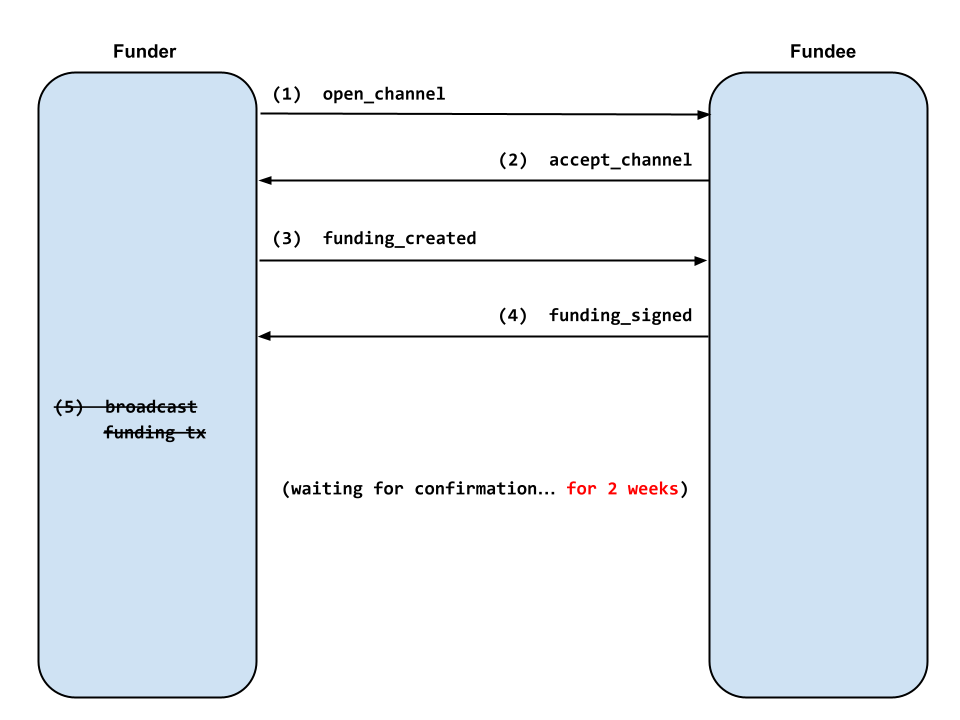
DoS: Fake Lightning Channels
Lightning nodes released prior to the following versions are susceptible to a DoS attack involving the creation of large numbers of fake channels:
If you are running node software older than this, your funds may be at risk! Update to at least the above versions to help protect your node.
The vulnerability
When one lightning node (the funder) wishes to open a channel to another node (the fundee), the following sequence of events takes place:

- The funder sends an
open_channelmessage with the desired parameters for the channel. - The fundee checks that the channel parameters are reasonable and then sends
an
accept_channelmessage. - The funder creates the funding transaction and sends a
funding_createdmessage containing the funding outpoint and their signature for the commitment transaction. - The fundee verifies the funder’s commitment signature and sends
funding_signedwith their own signature for the commitment. The fundee begins watching the chain for the funding transaction. - The funder verifies the fundee’s commitment signature, broadcasts the funding transaction, and then watches for it to show up onchain.
- Both nodes send
channel_readyonce the funding transaction has enough confirmations. Payments can now be sent across the channel.
But what happens if the funder doesn’t broadcast the funding transaction in step 5?

The fundee, eager for inbound liquidity, is willing to wait for the funding transaction to confirm for a period of time. But eventually the fundee needs to give up on the pending channel and reclaim the resources allocated to it. BOLT 2 recommends waiting for 2016 blocks (2 weeks) before abandoning the pending channel.
Thus for 2 weeks the fundee devotes some amount of database storage, RAM, and CPU time to watching for the pending channel to confirm.
The fake channel DoS attack
An attacker can thus force a victim node to consume a small amount of resources by opening a fake channel with the victim and never publishing it onchain. If the attacker can create lots of fake channels, they can lock up lots of the victim’s resources.
Fake channels are trivial to create. Since there is no way for the victim
to verify the funding outpoint sent to them in the funding_created message,
the attacker doesn’t even need to construct a real funding transaction. They
can use a randomly-generated funding transaction ID and sign a commitment
transaction based on that fake ID. The victim will successfully verify the
commitment signature against the provided (fake) funding outpoint and gladly
allocate resources for the fake pending channel.
Opening lots of these fake channels is also trivial against node software older than the above releases. Some older node implementations do impose a limit on the number of pending channels allowed per peer, but such limits are easily bypassed by using a new attacker node ID for each fake channel.
DoS effects
In my experiments, I was able to create hundreds of thousands of fake channels against victim nodes (owned by me), with all kinds of adverse effects. In some cases, funds were clearly at risk of being stolen due to the victim node’s inability to respond to cheating attempts.
Here’s how the DoS attack affected each node implementation.
LND
Over the course of a couple days, LND’s performance degraded so drastically that it stopped responding to requests from its peers or from the CLI. The performance degradation continued on restart, even if the attacker was no longer actively DoSing.
I didn’t continue the DoS experiment for more than a couple days, but it’s very possible that with enough time the victim node would have become unresponsive enough that funds could be stolen without consequence.
CLN
After one day of the DoS attack, CLN’s connectd daemon was completely blocked
and unable to respond to connection requests from other nodes. Most other
functionality of CLN continued to work, and funds were not at risk since the
separate lightningd daemon was not blocked by the DoS attack.
eclair
One day into the DoS, eclair OOM crashed. After that, every time eclair restarted, it OOM crashed again within 30 minutes, even if the attacker was no longer actively DoSing. Funds were clearly at risk, since an offline node cannot catch cheating attempts.
LDK
Since LDK is a library and not a full node implementation, it was trickier to experiment with. LDK Node didn’t exist at the time, but I found the ldk-sample node and modified it to run on mainnet for the experiment.
Within hours of the DoS attack, ldk-sample’s performance degraded drastically, causing it to unsync with the blockchain. A few days later, ldk-sample’s view of the blockchain was pinned more than 144 blocks in the past, preventing it from responding to cheating attempts before the attacker’s CSV timelock expired.
DoS defenses
I reported the DoS vector to the 4 major lightning implementations around the start of 2023. eclair and LDK were already aware of the potential DoS vector but hadn’t realized the severity of the vulnerability. Within days of receiving my report, every lightning implementation began working on defenses, some openly and others in secret.
All implementations have now shipped releases with defenses against the DoS. If you’re interested in the technical details of the defenses, see the linked pull requests and commits.
| Date Reported | Implementation | Defenses | Release |
|---|---|---|---|
| 2022-12-12 | LND | pending channel limit [1] | 0.16.0 |
| 2022-12-15 | CLN | significant performance improvements [1, 2] | 23.02 |
| 2022-12-28 | eclair | pending channel and peer limits [1, 2] | 0.9.0 |
| 2023-01-17 | LDK | pending channel and peer limits [1] | 0.0.114 |
Lessons
Use watchtowers
When all else fails, watchtowers help to protect funds if your lightning node is incapacitated by a DoS attack. If you have significant funds at risk, it’s cheap insurance to run a private watchtower on a separate machine.
Multiple processes
Prior to the above releases, CLN was the only lightning implementation that
clearly kept user funds safe while
under DoS, because CLN actually runs as multiple separate daemon processes. In
the case of this DoS attack, the connectd daemon responsible for handling
peer connections became locked up while the lightningd daemon watching the
blockchain was relatively unaffected.
Multiprocess architectures in general provide some defense against DoS, as
one process slowing down or crashing doesn’t automatically bring down the other
processes. For this reason, other implementations may want to consider
splitting their nodes into separate processes. CLN could also improve
robustness further by attempting to restart DoS-able subdaemons like connectd
and gossipd if they crash, rather than shutting the whole node down.
More security auditing needed
I discovered this DoS vector last year. I had been reviewing the dual funding protocol and found a griefing attack involving fake dual-funded channels. After discussing the attack with Bastien Teinturier, I came to realize that a similar attack may also affect the single-funded protocol.
But I convinced myself for a couple months that surely such a trivial attack would have been defended against already. It wasn’t until I spent some time studying implementations’ funding code that I realized there were no defenses.
The fact that this DoS vector went unnoticed since the beginning of the Lightning Network should make everyone a little scared. If a newcomer like me could discover this vulnerability in a couple months, there are probably many other vulnerabilities in the Lightning Network waiting to be found and exploited.
For quite some time, it seems that security and robustness have not been the top priority for node implementations, with some implementations not even having security policies until 6-10 months ago [1, 2]. Everyone wants new lightning features: dual funded channels, Taproot channels, splicing, BOLT 12, etc. And those things are important. But every one of them introduces more complexity and more potential attack surface. If we’re going to make lightning even more complex, we also need to ramp up the engineering effort we put towards making the network secure and robust.
Because in the end it doesn’t matter how feature-rich and easy-to-use the Lightning Network is if it can’t keep user funds safe.
